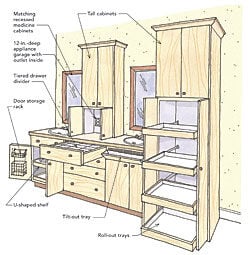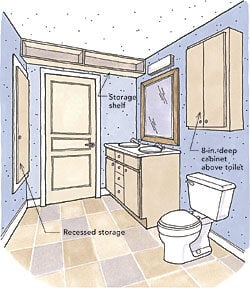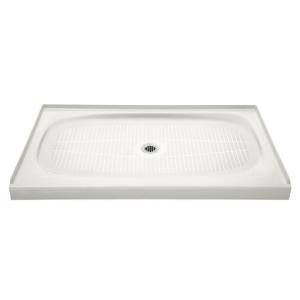Orginally posted on FineHomeBuilding.comby Jamie Goldberg
The house I grew up in had only one full bathroom, which my parents, sister, brother, and I shared. Somehow, we made it work, as do millions of families today. But almost any bathroom will work better if a little more storage is added to the mix. The best time to maximize a bathroom’s storage capacity is, of course, at the design stage, but you can explore plenty of storage-boosting options while remodeling or simply when updating fixtures and cabinetry.
Whether incorporated into the original design or added after the fact, bathroom-storage expansion its into three categories: (1) increasing the capacity of traditional storage areas like vanity cabinets; (2) maximizing existing floor and wall space with new storage options; and (3) identifying storage possibilities in spaces that are not traditionally used for storage. These approaches are outlined on the next page, and strategies from all three are used in the illustrated examples.
The Full-Function Vanity
 It’s not uncommon even for large vanity units to fall short on functional storage. In this example, the space between the sinks is wider than 30 in., allowing a stacked 24-in.-wide butt-door cabinet pair. The double doors and lack of a center stile allow access from both sides. The lower unit is backless and contains a wall outlet, making it useful for housing and charging electric shavers and electric toothbrushes. The 12-in.-deep space above houses daily-use items that are too large for the medicine cabinets.
It’s not uncommon even for large vanity units to fall short on functional storage. In this example, the space between the sinks is wider than 30 in., allowing a stacked 24-in.-wide butt-door cabinet pair. The double doors and lack of a center stile allow access from both sides. The lower unit is backless and contains a wall outlet, making it useful for housing and charging electric shavers and electric toothbrushes. The 12-in.-deep space above houses daily-use items that are too large for the medicine cabinets.
False panels in the sink bases have been converted to tilt-out trays for toothpaste and dental-floss storage. Doors are equipped with storage racks, including one for hair dryers. If extra storage is needed, U-shaped shelves can double the capacity of the sink cabinets. The center drawer’s functionality is increased with a tiered divider, while the basic linen tower has been made more useful with a quartet of roll-out trays in the lower section.
The Compact Bath
 This typical, small master bath offers occupants two sinks and a shared drawer bank but not much more in the way of storage. National Kitchen & Bath Association design guidelines recommend 30 in. of clearance (or a minimum of 21 in.) in front of the vanity and toilet, eliminating the opportunity for floor storage on the opposite wall. However, a 12-in.-deep shelf runs the length of the wall above the entry door to hold occasional-use items. The shelf can be supported by L-brackets or decorative supports, as long as they don’t interfere with the door swing below. Taking advantage of otherwise unusable space behind the in-swing door is a tall, shallow cabinet installed between the wall studs. It holds occasional-use items that might otherwise be stored in a recessed medicine cabinet, freeing that valuable point-of-use space for daily needs. An 8-in.-deep cabinet above and within reach of the toilet offers point-of-use storage for spare rolls of tissue and other items.
This typical, small master bath offers occupants two sinks and a shared drawer bank but not much more in the way of storage. National Kitchen & Bath Association design guidelines recommend 30 in. of clearance (or a minimum of 21 in.) in front of the vanity and toilet, eliminating the opportunity for floor storage on the opposite wall. However, a 12-in.-deep shelf runs the length of the wall above the entry door to hold occasional-use items. The shelf can be supported by L-brackets or decorative supports, as long as they don’t interfere with the door swing below. Taking advantage of otherwise unusable space behind the in-swing door is a tall, shallow cabinet installed between the wall studs. It holds occasional-use items that might otherwise be stored in a recessed medicine cabinet, freeing that valuable point-of-use space for daily needs. An 8-in.-deep cabinet above and within reach of the toilet offers point-of-use storage for spare rolls of tissue and other items.
The Maximized Master Bath
 This remodeled bath maximizes daily point-of-use space in all three functional areas: tub, vanity, and toilet. The water closet features a floor cabinet for backup toilet paper, a toilet brush, and toilet-cleaning supplies. The wall cabinets above the toilet, only 8 in. deep to avoid collisions, hold supplies within reach of the user. Occasional-use items for the water closet can be stored in the upper section. The shower includes double niches to hold each occupant’s bathing necessities. One is within 15 in. of the shower bench for easy reach. The tub deck is extended with storage in front for towels and other bath essentials. The deeper deck also facilitates a safer sit-and-swivel entry. In the vanity area, the linen tower offers space for a roll-out hamper in the bottom section. The opposite vanity takes advantage of an extrawide countertop to offer additional storage above for small electric devices with access to an outlet. Each wall cabinet is only 12 in. deep to allow counter space in front. Three ways to boost bathroom storage
This remodeled bath maximizes daily point-of-use space in all three functional areas: tub, vanity, and toilet. The water closet features a floor cabinet for backup toilet paper, a toilet brush, and toilet-cleaning supplies. The wall cabinets above the toilet, only 8 in. deep to avoid collisions, hold supplies within reach of the user. Occasional-use items for the water closet can be stored in the upper section. The shower includes double niches to hold each occupant’s bathing necessities. One is within 15 in. of the shower bench for easy reach. The tub deck is extended with storage in front for towels and other bath essentials. The deeper deck also facilitates a safer sit-and-swivel entry. In the vanity area, the linen tower offers space for a roll-out hamper in the bottom section. The opposite vanity takes advantage of an extrawide countertop to offer additional storage above for small electric devices with access to an outlet. Each wall cabinet is only 12 in. deep to allow counter space in front. Three ways to boost bathroom storage
1. Increase the capacityof traditional areas • Add two-tiered organizers to any 4-in. or taller vanity drawer boxes, thus creating extra half-drawers without altering the existing cabinet. • Install a storage rack on the back of every vanity base-cabinet door. Special racks are available for space-hogging hair dryers. • Add roll-out trays to the bottom of base cabinets, and use them in place of shelves in linen towers, making what’s stored in the back more visible and accessible. • Wrap a U-shaped shelf around undersink plumbing to add an extra level of storage. • Convert the false panel below a vanity countertop to a tilt-out tray.
2. Maximize existing floor, surface, and wall space • Maximize point-of-use vanity storage with countertop cabinetry. Use 12-in.-deep cabinets, keeping them at least 3 in. from the sink edge to prevent water damage. The cabinets can extend to the ceiling with a decorative crown molding, or stop a foot lower if there’s a vent or light above. Regardless of height, they should be finished with a topcoat that protects against moisture, and be kept as dry as possible to prevent moisture damage at the point of contact with the vanity top. • Increase point-of-use commode storage. If it is not situated under a window, install a single or stacked cabinet to the ceiling above the toilet. It should be low enough for a seated user to reach inside and extend no farther out than the toilet tank to avoid causing injury. • If there is a window directly above the toilet, space might still exist for a shorter cabinet or shelf to be installed between the window and the ceiling for backup supplies. Ensure that the bottom is finished because it will be highly visible. • Take advantage of unused floor space to create a built-in furniture armoire, floor cabinet, or storage bench for backup and occasional-use items. Remember to allow for clearances when adding storage of this type. National Kitchen & Bath Association design guidelines recommend 30 in. in front of a vanity, commode, or shower. NKBA guidelines are often more stringent than building codes, but be sure to check local requirements to ensure that you’re in compliance whenever undertaking a bathroom project.
3. Identify storage possibilities in nontraditional spaces • Add a finished shelf above the bathroom entry door to take advantage of otherwise unused space for occasional-use items. Whenever possible, run it wall to wall. • Take advantage of the forgotten space behind an in-swing door by building a tall, shallow cabinet into the wall between studs. • Create a shower-wall niche for each bathroom occupant to accommodate daily point-of-use bathing items. At least one should be built within 15 in. of the shower bench for seated access. • Plan open-storage cubbies for towels or bath supplies on the front end or exposed side of a new tub deck. • Plan built-in, open wall-shelving units at one or both ends of a tub-only enclosure for daily point-of-use bathing items in storage baskets.
Drawings: Martha Garstang Hill
From Fine Homebuilding217 , pp. 88-92 January 20, 2011 © 2012 The Taunton Press, Inc. More good stuff from Fine Homebuilding here.


.png?width=350&height=350&name=@designremodel%20home%20remodeling%20cost%20guide%20on%20cape%20cod%20(1).png)


